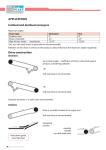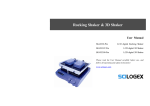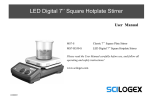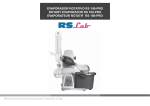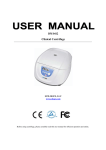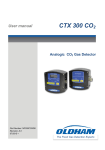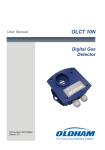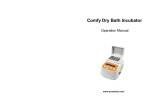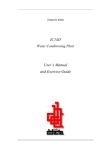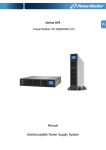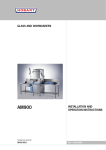Download SCILOGEX RE100-Pro Rotary Evaporator manual
Transcript
Rotary Evaporator User Manual RE100-Pro LCD Digital Rotary Evaporator Please read the User Manual carefully before use, and follow all operating and safety instructions! www.scilogex.com Contents Preface ................................................................................. 1 Service ................................................................................. 1 Warranty .............................................................................. 1 1. Safety Instructions ....................................................... 2 2. Proper Use ................................................................... 5 3. Inspection .................................................................... 6 3.1 Receiving Inspection ............................................. 6 3.2 Listing of Items ..................................................... 6 4. Control and Display..................................................... 6 4.1 Control elements.................................................... 6 4.2 Display................................................................... 8 5. Installation and Operation ........................................... 9 5.1 Installation ............................................................. 9 5.2 Operation ............................................................. 12 6. Faults ......................................................................... 13 7. Maintenance and Cleaning ........................................ 14 8. Associated Standards and Regulations ...................... 15 9. Specifications ............................................................ 16 Rotary Evaporator Preface Please provide the customer care representative with the Welcome to the “Rotary Evaporator User Manual”. Users should read this Manual carefully, follow the instructions and procedures, and be aware of all the cautions when using this instrument. following information: • Serial number(on the rear panel) • Certification • Description of problem (i.e., hardware or software) • Methods and procedures adopted to resolve the problems • Your contact information Service Warranty When help needed, you can always contact the Service Department of manufacturer for technical support in the following ways: This instrument is warranted to be free from defects in materials and workmanship under normal use and service, for a period of 24 months from the date of invoice. The warranty is extended only to the original purchaser. It shall not apply to any product or parts which have been damaged on account of improper installation, improper connections, misuse, accident or abnormal conditions of operation. For claims under the warranty please contact your local supplier. You may also send the instrument directly to manufacturer, enclosing the invoice copy and by giving reasons for the claim. SCILOGEX, LLC 500 Four Rod Road Suite 122 Berlin, CT 06037 USA Tel: 1-860-828-5289 Fax: 1-860-828-5389 E-mail: [email protected] Http://www.scilogex.com 1 Rotary Evaporator 1. Safety Instructions • Read the operating instructions in full before starting up and follow the safety instructions. • Keep the operating instructions in a place where they can be accessed by everyone. • • Ensure that only trained staff work with the appliance. Follow the safety instructions, guidelines, occupational health and safety and accident prevention regulations. When working under a vacuum in particular! • Wear your personal protective equipment in accordance with the hazard category of the medium to be processed. Otherwise there is a risk of: - splashing liquids, - body parts, hair, clothing and jewellery getting caught, - injury as a result of glass breakage. • • CAUTION! Inhalation of or contact with media such as poisonous liquids, gases, spray mist, vapours, dusts or biological and microbiological materials can be hazardous to user. Set up the device in a spacious area on an even, stable, clean, non-slip, dry and fireproof surface. 2 • Ensure that there is sufficient space above the device as the glass assembly may exceed the height of the device. • Prior to each use, always check the device, accessories and especially the glass parts for damage. Do not use damaged components. • Ensure that the glass assembly is tension-free! Danger of cracking as a result of: - stress due to incorrect assembly, - external mechanical hazards, - local temperature peaks. • Ensure that the stand does not start to move due to vibrations respectively unbelance. • Beware of hazards due to: - flammable materials, - combustible media with a low boiling temperature, - glass breakage. • CAUTION! Only process and heat up media that has a flash point higher than the adjusted safe temperature limit of the heating bath that has been set. • The safe temperature limit of the heating bath must always be set to at least 25 °C lower than the fire point of the media used. Rotary Evaporator • Do not operate the appliance in explosive atmospheres, with hazardous substances or under water. • Only process media that will not react dangerously to the extra energy produced through processing. This also applies to any extra energy produced in other ways, e.g. through light irradiation. of the distillation equipment. The cooler must work properly. Monitor the coolant flow rate at the cooler outlet. • The glass equipment must always be ventilated when working under normal pressure (e.g. open outlet at cooler) in order to prevent a pressure build-up. • Please note that dangerous concentrations of gases, vapours or particulate matter can escape through the outlet at the cooler. Take appropriate action to avoid this risk, for example, downstream cold traps, gas wash bottles or an effective extraction system. • Tasks with the device must only be performed when operation is monitored. • Operation with excess pressure is not permitted (for cooling water pressure see "Technical Data"). • Do not cover the ventilation slots of the device in order to ensure adequate cooling of the drive. • There may be electrostatic discharges between the medium and the drive which could pose a direct danger. Evacuated glass vessels must not be heated on one side; the evaporating flask must rotate during the heating phase. • The glassware is designed for operation under a vacuum of up to 10 mbar. The equipment must be evacuated prior to heating (see chapter ”Commissioning”). The equipment must only be aired again after cooling. When carrying out vacuum distillation, uncondensed vapours must be condensed out or safely dissipated. If there is a risk that the distillation residue could disintegrate in the presence of oxygen, only inert gas must be admitted • • • The appliance is not suitable for manual operation. Safe operation is only guaranteed with the accessories described in the ”Accessories” chapter. • Refer to the operating instructions for the accessories, e.g. vacuum pump. • Only use the device under an all side-closed exhaust, or a compa rable protective device. • Adapt the quantity and the type of distilland to the size 3 Rotary Evaporator for stress relief. • • • • mechanism to lift the evaporator piston out of the heating bath. Evacuate the danger zone and warn those in the surrounding area! CAUTION! Avoid peroxide formation. Organic peroxides can accumulate in distillation and exhaust residues and explode while decomposing! Keep liquids that tend to form organic peroxides away from light, in particular from UV rays and check them prior to distillation and exhaust for the presence of peroxides. Any existing peroxides must be eliminated. Many organic compounds are prone to the formation of peroxides e.g. dekalin, diethyl ether, dioxane, tetrahydrofuran, as well as unsaturated hydrocarbons, such as tetralin, diene, cumene and aldehydes, ketones and solutions of these substances. DANGER OF BURNING! The heating bath, tempering medium, evaporator piston and glass assembly can become hot during operation and remain so for a long time afterwards! Let the components cool off before continuing work with the device. ATTENTION! Avoid delayed boiling! Never heat the evaporating flask in the heating bath without switching on the rotary drive!Sudden foaming or exhaust gases indicate that flask content is beginning to decompose. Switch off heating immediately. Use the lifting 4 • When the device is switched off or the power supply disconnected, the internal safety lift removes the evaporator piston from the heating bath. • CAUTION! Never operate the device when the evaporator piston is rotating and the lift is raised. Always lower the evaporator piston into the heating bath first before starting the rotation drive. Otherwise hot tempering medium may be sprayed out! • Set the speed of the drive so no tempering medium is sprayed out as a result of the evaporator piston rotating in the heating bath. If necessary reduce the speed. • • Do not touch rotating parts during operation. Imbalance may result in uncontrolled resonance behaviour of the device or assembly. Glass apparatus may be damaged or destroyed. In the event of unbalance or unusual noises, switch off the appliance immediately or reduce the speed. • The appliance does not start up again automatically following a cut in the power supply. • The device is only disconnected from the power Rotary Evaporator supply network if the device power switch is off or the plug is pulled out. • The socket for the mains cord must be easily accessible. • The voltage stated on the type plate must correspond to the mains voltage. • • Socket must be earthed (protective ground contact). Removable parts must be refitted to the appliance to prevent the infiltration of foreign objects, liquids etc. • Protect the appliance and accessories from bumps and impacts. • The appliance may only be opened by experts. 2. Proper Use The instrument is designed for distilling in schools, laboratories or factories. Together with the accessories recommended by manufacturer, the device is suitable for: - quick and gentle distillation of liquids - evaporation of solutions and suspensions - crystallisation, synthesis or cleaning of fine chemicals - drying of powder and granulate material - recycling of solvents This device is not suitable for using in residential areas or other constraints mentioned in Chapter 1. 5 Rotary Evaporator 3. Inspection 4. Control and Display 3.1 Receiving Inspection 4.1 Control elements Unpack the equipment carefully and check for any damages which may have arisen during transport. Please contact manufacturer/supplier for technical support. Motor Condenser Note: If there is any apparent damage to the system, please do not plug it into the power line. Evaporating flask Receiving flask Heating bath Operation panel 3.2 Listing of Items The package includes the following items: Items Figure 1 Qty Main unit 1 Heating bath 1 Power cable 1 Glassware vertical 1 User Manual 1 Heating bath connector Power supply Figure 2 Table 1 6 USB Rotary Evaporator Items LED power Lift-up key Lift-down key LCD display Int key Speed key Temperature key Speed key Speed Push the key and then rotate control knob to set the rated speed in the range from 20 to 280. Temperature key Temp Push the key and then rotate control knob to set the rated temperature in the range from room temperature to 180°C. Timer key Timer Push the key and then rotate control knob to set the rated time in the range from 1 to 999min. Int key Int Push the key and then rotate control knob to set the interval for right-left running in the range from 1 to 999s. Control knob Clockwise rotate to increase program values. Rotate anti-clockwise to decrease program values. Press the knob, switch ON/OFF the unit. Lift-up key Press the key, the lift goes up. Release the key the lift stops and remains in that position. Lift-down key Press the key, the lift goes down. Release Control knob Timer key Figure 3 Power switch Figure 4 7 Descriptions Rotary Evaporator the key the lift stops and remains in that position. LCD display LCD displays the real working state. Display LED power Power ON, LED power flash. When the unit running, LED power is lit. Remote Power switch Power ON or OFF. Probe Table 2 4.2 Display Remote control External probe Rotate Temperature Temperature symbol Timer Interval Timer display area Interval display area Display when using external probe. Display when the rotating function is switched ON. Temp Display when the heating function is switched ON. Timer Display when timer function is switched ON. Int Display when “Int” function is switched ON. Speed display area When setting speed, displaying the setting value and flashed. The setting value does not flash until real speed reaches the set point. Speed symbol Display when the rotating function is switched ON. Temperature display area When setting temperature, displaying the setting value. When the heating function is switched ON, displaying the real Figure 5 8 Display in case of remote control. Mot Speed display area Speed symbol Descriptions Rotary Evaporator value. Figure 6 Temperature symbol Display when the heating function is switched ON. Timer display area When setting timer, displaying the rated time. When the timer function is switched ON, displaying remaining time. CAUTION! Loosen transportation lock (Figure 7). • Displaying the “Int” target value. Hold the lift with your hand on the height position and remove the thumb screw on the back of the appliance (a). • Once the transportation lock has been removed, the lift moves slowly to its upper end position. The distance is 150mm. • Connect the device to the power supply using power cable (b). • Connect the heating bath to the device (c). Interval display area Table 3 5. Installation and Operation 5.1 Installation • Adjustable base (Figure 6). a b 9 c Rotary Evaporator • Then lock the locking device by turning it clockwise by 60°. • The plastic screw nut (f) helps loosen tight-fitting piston ground-in connections (Figure 9). Figure 7 • • • Remove the clamping device for the angle setting of the rotation drive on the right side of the lift by rotating the knurled screw (d) counter clockwise. - Set the drive at an angle of approx.30°(Figure 8) Then secure the rotation drive from being accidentally turned by tightening the knurled screw in a clockwise direction. Hold the tight-fitting evaporator piston and counter clockwise (e), and then turn the plastic screw nut (f) until the evaporator piston neck. e d f Figure 9 Note: Prior to commissioning, hand-tighten the plastic screw nut (f) left-aligned. Figure 8 • Open the locking device on the drive head by turning it 60°counter clockwise (e), (Figure 9). • Feed the steam pipe in until it stops. • 10 Installing condenser seal (Figure 10 and Figure 11). Rotary Evaporator device at 200 rpm for 2 min. Then tighten the cap nut firmly. g h i Figure 10 Figure 12 h Figure 11 • Figure 13 Installing condenser (g) (Figure 12 and Figure 13). - Load the cap nut (h) and locking spring (i) to condenser in turn. - • Tighten the cap nut hand-screwed (h). Start the 11 Installing the vertical glassware condenser locking device (Figure 14). Rotary Evaporator • Connecting tubes (Figure 15). Vacuum tube Cooling water Cooling water Figure 14 Figure 15 5.2 Operation 12 • Make sure the required operating voltage and power supply voltage match. • • Ensure the socket must be properly grounded. Plug in the power cable,ensure the power is on and begin initializing. • Press Lift-up/Lift-down key, the lift goes up/down. Rotary Evaporator Release Lift-up/Lift-down key, the lift stops. • 6. Faults Push the speed key and then rotate control knob to set the rated speed. • • Push the temperature key and then rotate control knob to set the rated temperature. Instruments can’t be power ON - Check whether the power line is unplugged - Check whether the fuse is broken or loose • Push the timer key and then rotate control knob to set the rated time. Deactivate the timer by setting the target value to “0”. • Fault in power on self test - Switch OFF the unit, then switch ON and reset the instruments to factory default setting. • Press the Int key and then rotate control knob to set the rated interval value. Deactivate the interval by setting the target value to “0”. If these faults are manufacturer/supplier. • Press the control knob, switch ON. If these operations above are normal, the device is ready to operate. If not, the device may be damaged during transportation, please contact manufacturer/supplier for technical support. Warning ! Forbid to transfer the flask when the instrument working. 13 not resolved, please contact Rotary Evaporator 7. Maintenance and Cleaning • Proper maintenance can keep instruments working properly and lengthen its lifetime. • Do not spray cleanser into the instrument when cleaning. • • • Unplug the power line when cleaning. Only use recommended cleansers: Dyes Construction materials Cosmetics Foodstuffs Fuels • Isopropyl alcohol Water containing tenside / Isopropyl alcohol Water containing tenside / Isopropyl alcohol Water containing tenside Water containing tenside Before using other method for cleaning or decontamination, the user must ascertain with the manufacturer that this method will not harm the instrument. Wear the proper protective gloves during cleaning of the instrument. Note: • Electronic device can not clean with cleanser. • If you require maintenance service, must be cleaned the instrument in advance to avoid pollution of hazardous substances, and to send back into original packing. • If the instrument will not use for a long time, please switch off and place in a dry, clean, room temperature and stable location. Rotary Evaporator 8. Associated Regulations Standards interference when the equipment is operated in a commercial environment. This equipment generates, uses, and can radiate radio frequency energy and, if not installed and used in accordance with the instruction manual, may cause harmful interference to radio communications. Operation of this equipment in a residential area is likely to cause harmful interference in which case the user will be required to correct the interference at his own expense. and Construction in accordance with the following safety standards: EN 61010-1 UL 3101-1 CAN/CSA C22.2(1010-1) EN 61010-2-10 Construction in accordance with the following EMC standards: EN 61326-1 Associated EU guidelines: EMC-guidelines: 89/336/EWG Instrument guidelines: 73/023/EWG Changes or modifications not expressly approved by the party responsible for compliance could void the user's authority to operate the equipment. NOTE: This equipment has been tested and found to comply with the limits for a Class A digital device, pursuant to Part 15 of the FCC Rules. These limits are designed to provide reasonable protection against harmful 15 Rotary Evaporator 9. Specifications Items Specifications Voltage [VAC] 100-240 Frequency [Hz] 50/60 Power [W] 1400 Motor External rotor brushless motor Speed Range [rpm] 20-280 Speed Display LCD Temperature Range [°C] RT -180 Heat Control Accuracy [°C] ±1 Temperature Display LCD Heat Output [W] 1300 Lift Motor Stroke [mm] 150 Timer [min] 1-999 Overall [D×W×H ,mm] Dimensions Weight [kg] Permissible Temperature [°C] 465×457×583 15 Ambient 5-40 Permissible Relative Humidity 80% Protection Class acc. To DIN EN60529 IP20 USB Yes Table 4 SCILOGEX, LLC 500 Four Rod Road Suite 122 Berlin, CT 06037 USA Tel: 1-860-828-5289 Fax:1-860-828-5389 E-mail: [email protected] Http://www.scilogex.com





















